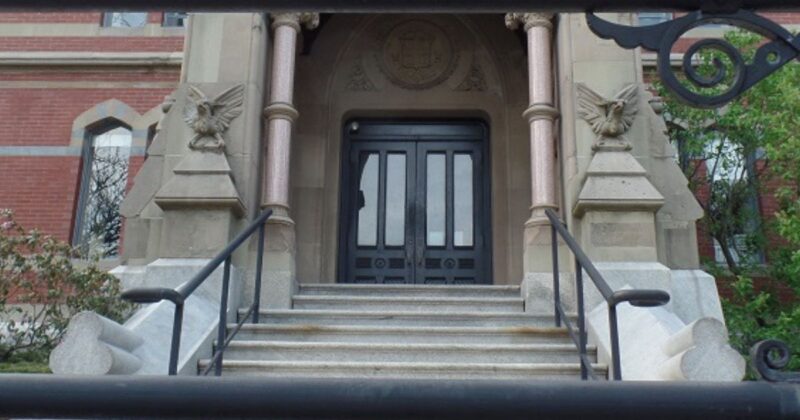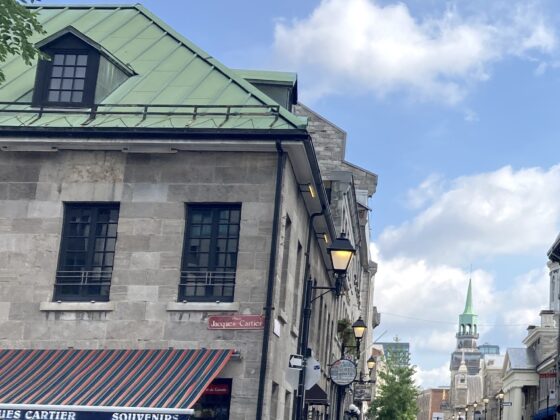by Robert Anasi
I never can be tied to raw new things,
For I first saw the light in an old town,
Where from my window huddled roofs sloped down
To a quaint harbour rich with visionings.
Streets with carved doorways where the sunset beams
Flooded old fanlights and small window-panes,
And Georgian steeples toppd with gilded vanes –
These are the sights that shaped my childhood dreams.
– H.P. Lovecraft (written on his memorial plaque near the entrance to the John Hay Library at Brown University).
Standing at the top of Jenckes Street in Providence, Rhode Island, I am looking down, way down, between lines of historic houses. The road is so steep there’s a stone wall at the bottom to keep the next car with faulty brakes out of someone’s living room. Further away, I can see downtown and Federal Hill across the city. The city center looks nothing like it did when I was a boy. Rivers have been moved, bridges demolished, and high-rises built … yet the street around me is the same. In fact, it seems little different from H.P. Lovecraft’s description of it in his short novel, The Case of Charles Dexter Ward, even though Lovecraft was writing about the street as it was in 1900, when the neighborhood was already old.
He would hesitate gingerly down vertical Jenckes Street with its bank wall and colonial gables to the shady Benefit Street corner. It was getting to be a slum here but the titan elms cast a reassuring shadow over the place and the boy would stroll south past the long lines of the pre-Revolutionary homes with their great central chimneys and classic portals – Young Charles could picture them as they were when the street was new, and red heels and periwigs set off the painted pediments whose signs of wear were now becoming so visible.
No matter where you go on the east side of Providence, you can’t help but slide back through the centuries. I grew up in the city and it happened to me a thousand times. The past is alive and it played an essential role in shaping the imagination of the man who created modern horror writing.
H.P. Lovecraft was born in Providence on August 20, 1890. In his childhood, living links to the city’s colonial heritage remained. His mother’s family originated from the Plymouth Colony and Howard Philips knew Providence’s oldest families. On the East Side in those days, he could run into an Angell on Angell Street, meet Tabers on Taber, or have lunch in a mansion built by his host’s ancestors. A scholarly boy, Lovecraft dedicated his early years to scientific and historic research and writing poetry in imitation of Restoration authors like Pope. The deaths of his father (from syphilis) and his grandfather brought financial ruin to the family and drove his mother insane. Lovecraft was forced to find ways to earn a living, mostly by ghostwriting for clients who included Harry Houdini.
The family tragedies affected Lovecraft’s health and intensified his distrust of the modern world, especially immigrants, who he typically referred to as ‘steaming mongrel flesh.’ These immigrants – including my own Irish great-grandparents – were rapidly changing the East Side. In his fiction, Lovecraft often used historical figures like Moses Brown or gave his characters local-family names to memorialize a lost age.
You don’t have to be a member of the gentry to love Providence though, and I spent my teen years wandering through the city. An Indian war band burned down the early settlement in 1675 but after that the architectural line remained unbroken. Today the East Side is an open-air museum with 18th century farmhouses, Federal-style homes, Georgian mansions built with triangle-trade profits (slaves, sugar and rum) and even bigger Victorian follies. The East Side opens to the walker, its steep hills constantly unfolding new perspectives like those on Prospect Terrace.
One of the child’s first memories was of the great westward sea of hazy roofs and domes and steeples and far hills which he saw one winter afternoon from that great railed embankment, all violet and mystic against a fevered, apocalyptic sunset of reds and golds and purples and curious greens. The vast marble dome of the state Houses stood out in massive silhouette, its crowning statue haloed fantastically by a break in one of the tinted stratus clouds that barred the flaming sky.
– The Case of Charles Dexter Ward
While any number of ugly buildings deface the East Side (most courtesy of Brown University) they haven’t destroyed its character. Luckily, Providence in the 1960s was too poor to engage in the urban ‘renewal’ that demolished old cities like New Haven and Hartford.
Growing up in Providence saved me from the suburbs, where car culture condemns teenagers to a limbo of tract-housing and strip malls. In the city, even though I didn’t have anything to do, I always had somewhere to go. With few exceptions, my teachers taught me nothing about local history, but anyone who wasn’t sedated could feel the past; it was right outside the classroom windows.
On long walks, I’d gradually forget that I was broke and powerless and that the girl I loved (the most beautiful girl in the world) was sleeping with somebody else. I was a ghost in my own life and the only freedom I had was that no one paid attention to me, so I could creep almost anywhere. The city helped me escape, drawing me out myself until I was floating over the street. In my elevated state, scenes and events took on mysterious significance. I walked past bars and stood under windows absorbing the strange interactions of other people but mostly I just looked at the old houses and trees.
The same past that made Providence precious to Lovecraft made it precious to me.
Although I didn’t know what carriage houses or widow’s walks were, I understand that didn’t they come from the world of the 1980s. On my walks I was looking for the same thing I looked for in the horror, science fiction, and fantasy books I read by the thousands – another reality. Because if there were other realities than the possibility existed that I could have another life, that I wasn’t condemned to being a ghost.
As a reactionary snob, Lovecraft seems an unlikely figure to have pioneered the slum genre of horror writing. In fact, he was so diffident about his macabre tales that he didn’t even try to publish Charles Dexter Ward and his horror output is vastly outweighed by his poetry and essays. Yet from childhood, Lovecraft had a strong interest in fantastic tales, especially those of Edgar Allen Poe. Poe’s short life took him through Providence and Lovecraft – The Shunned House – describes Poe’s commute on Benefit Street between the Athaneum Library and the home of Sarah Helen Whitman, the poet Poe hoped to marry (Whitman told Poe he had to choose between her and the bottle. Poe picked the bottle and died at forty).
On his walks, Poe would often stop at small churchyard behind St. John’s Cathedral. The churchyard was already old when Poe, and later Lovecraft, sat there absorbing the somber atmosphere. Only a few yards from one of the busiest streets in the city, the rows of simple slate tombstones are toppling, the inscriptions faded with age. One from the 1700s that’s still legible reads, ‘Three Respectable Black Persons, Phillis, Rose and Fannie Chace, Who Served in the Family of Sam’l Chace Esq.’
When I found out at age sixteen that Lovecraft and Poe had hung out in the churchyard, well, I had to hang out there too. I liked it best at twilight when the late sun turned the tombstones mauve and long shadows crawled over the cathedral walls. I also liked the churchyard at night. Despite the zombie and vampire films I consumed in those days, St. John’s never seemed dangerous. It was as peaceful as a park but the graves gave it a special intensity. To me a graveyard concentrates the sense of the past and dims the static of the everyday world. I like to think that’s what brought Lovecraft and Poe there. In their desperate lives, it was one place where they could think without the petty distractions of the living. Being in a graveyard helped those connoisseurs of fear and death get into the mood.
A horror’s writer’s theme is fear, of course, and Lovecraft had particular ideas of what kind of fear this was. In an introduction to a book on supernatural horror, he wrote:
The oldest and strongest emotion of mankind is fear and the oldest and strongest kind of fear is fear of the unknown.
Lovecraft’s conservatism shaped his understanding of this fear; only a writer immersed in the traditions of a community could fully appreciate the dislocations of the 20th century. His parochialism led to his fear of immigrants – in his stories, degenerate immigrants are inevitably allied to the forces of darkness – but as a student of science, he was also aware of how discoveries in physics, biology and geology had displaced mankind from the center of the universe. In Lovecraft’s greatest fiction, he communicates a sense of alienation and displacement as his characters are overwhelmed by the cosmic forces at play around them.
The Color Out of Space may serve as a prescient warning of environmental and nuclear contamination but its impact comes from the unfathomable nature of the alien monster. Lovecraft attempted to describe the indescribable and see humanity from an inhuman perspective, as a tiny blotch on the world, nauseous and lost in immense gulfs of space and time. It’s this aspect of his work that has attracted the attention of modern critics and writers like Houellebecq (whose first published book was about Lovecraft). Yet although the streets and houses, and graveyards, of Providence gave Lovecraft a foundation in the chaos of the modern world, he was too perceptive not to sense the secrets that lay beneath his beautiful city.
‘I AM PROVIDENCE’ reads Lovecraft’s memorial headstone, a phrase taken from one of his more than seventy thousand extant letters. The marker stands in a cemetery on a slope where the East Side descends to the Blackstone River. Swan Point Cemetery was long a chic resting place for the city’s ruling class and the headstones name mayors, generals and governors. The writer certainly approved of his company. Every year around Halloween, Lovecraft acolytes descend on Swan Point, some more devoted than others. On October 14th, 1997, cemetery guards discovered a four foot hole in front of Lovecraft’s headstone, evidence of an unsuccessful attempt to reach the master’s bones. The grave robbers could have dug all the way to China however, as Lovecraft is actually a few yards away under a large obelisk for the Philips’ family (the memorial headstone was only installed in 1977).
When I was a toddler my father would bring me to a tree-bordered pond near the cemetery entrance. The pond had big goldfish and a block of granite in the center with a fountain. It was so miraculous to my brother and I that we would lie at the pond edge hypnotized by the fish, and my father could sit on a bench and smoke his Marlboros in peace. A few years later I’d go to Swan Point with my brother and best friend in our summer rambling, the pond seeming to vanish and reappear so that we could search for hours without finding it. The dead people never bothered us. They were certainly more amenable than living adults. With no danger of speeding automobiles, we would flash down the roads on our bicycles. Studying the headstones, we’d read the names out loud and determine how old people were when they died.
Emmanuel Lloyd was eighty-nine!
This baby was less than a year. She didn’t even have name!
We’d touch the weathered wreaths and stand on tiptoe to stare into the family crypts, hoping to see mummified bodies. From time to time, corteges of the black limousines passed us, headlamps dim in daylight. We’d slow our bikes and stare at the dark processions. Down slope, the river showed through patches in the canopy. We never came to the end of Swan Point, a foreign country as big to us as the Pacific Ocean.
If Lovecraft found his great theme in the cosmic alienation of humanity, he also described another, more intimate fear: the fear of history. Nowhere is this more evident than in his Providence stories. In The Case of Charles Dexter Ward, Ward – a Lovecraft stand in – is literally murdered by the past when he summons an evil ancestor from the dead, while The Shunned House has a Poltergeist-like plot in which a vengeful spirit devours the residents of a house built over its grave.
As much as Lovecraft idealized his city, he realized that its history included atrocities and holocausts too terrible to remember but impossible to forget, a shadow cast by the past onto the present. He may never have consciously admitted it, but his work reflects the fact that his city on a hill was constructed by the deaths of Indians, slaves, factory workers, and natives of places thousands of miles away. It was only with the recorded genocides 20th century that we’ve begun to fully recognize the enormity of the past crimes of our species, all our unmarked graves, unrecorded but inscribed in our unconscious.
On my last trip to Swan Point I get directions to Lovecraft’s grave and set off down the winding roads. Within a few minutes, I discover that Mr. Lovecraft is buried right next to my pond. I’d been going there for most of my life without realizing that I was walking on top of him. Lovecraft, I hope, would have appreciated the irony, and the continuity. Although I’m descendant of people he feared and despised, I share his love for Providence, in part because I’ve read his work.
At the pond, Lovecraft’s ‘I am Providence’ memorial marker has been removed – to discourage Goth pilgrims, I suppose – and tread marks from a back hoe crisscross the bare soil. The Philips obelisk is still there though and I looked at his dates: H.P. Lovecraft, 1890-1937. Although no drinker, Lovecraft outlived Poe by only few years, dead of a cancer that he ignored until treatment was impossible. Lovecraft’s friends seemed to think he welcomed the end. Perched on the edge of the 20th century, the writer looked into a clouded future but found it impossible to hide in the past.
For Lovecraft, destiny was malignant and understanding led to madness and death. Inevitably, his characters are damaged or destroyed by their encounters with the unknown. Much better, he thought to remain ignorant like oblivious children running over graves.
An award-winning writer and journalist, Robert Anasi has received a New York Foundation for the Arts Fellowship, as well as being named a Writer on the Verge by the Village Voice. His first book, The Gloves: A Boxing Chronicle, was chosen for Best of the Year lists by Sports Illustrated, Publisher’s Weekly, and the Washington Post.
This is a republished piece and was originally published in Literary Traveler in 2006.











